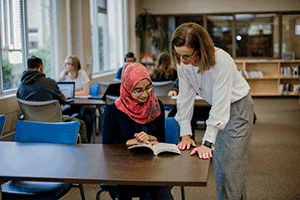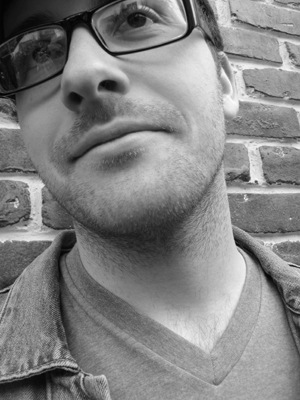Ready to learn more?
Get all the details straight to your inbox!

Living in The Student Village at Luther College, our student residence, comes with a choice of healthy, nutritious meal plans. That means no grocery shopping, no meals to cook, and no dirty dishes to worry about. You can focus on your studies and wellness!

Every degree program at Luther College offers a study abroad option and an optional experiential learning component where you gain real world experience and get paid while going to school!

Our student residence, The Student Village at Luther College, welcomes residents from ALL post-secondary institutions in Regina. Rooms come with a meal plan, free laundry, free wi-fi, and a great sense of community.

Luther College is recognized for its high standards of teaching, focused research, and one-on-one academic advising. We value and protect this heritage of excellence in scholarship, freedom of inquiry, and faithful seeking after truth.

Free enrolment counselling support and invaluable one-on-one academic advising are available for all programs at Luther College.

You can book a tour of Luther College, the U of R campus, and our student residence, The Student Village at Luther College, any time throughout the year. Contact our Recruitment Office at 1-306-206-2117.

The priority deadline for academic application is March 15. To book a personalized enrolment counselling appointment, contact our Recruitment Office at 1-306-206-2117.

Luther College students are eligible for nearly $100,000 in academic awards – in addition to scholarships and bursaries awarded by the U of R.
Get all the details straight to your inbox!
The sensationalism of the witch hunts dominates much of what one considers when exploring issues of magic during the early modern period, but the witchcraft trials was not the only area in which magic played a role. Throughout Europe between 1450 and 1700, belief in magic and sorcery was pervasive. A widely believed concept involving the presence of invisible, supernatural powers that could impact the affairs of people—both positively and negatively—was the basis of magic. Magic involved the attempt to take advantage of these powers for personal benefit. Even though the church attempted to discredit magical practice, there was a substantial gap between official doctrine and what was practiced by the general population. An interesting combination of magic and religion was involved in the daily lives of early modern commoners and at times they would utilize individual magical and spiritual practitioners who specialized in a multitude of beneficial magical services. Charms, prayers and rituals which incorporated some aspects of Christianity were commonly employed in attempts to provide a diverse array of benefits as well as protection from harmful magic, or maleficium, which was blamed for many of the hardships that plagued the European population during this period. For the most part, attempting to manipulate these powers was deemed superstitious by the religious establishment and after the Reformation doing so was only viewed with greater suspicion—although one might argue the hypocrisy of this since many religious practices involved an element of what might be considered “magic.” But despite the condemnation by the church and its proponents, it is clear that magical practices were, in one way or another, an integral aspect of the everyday lives of the common people of early modern Europe.
Life for the masses was wrought with difficulty. Drought, famine, disease, malnutrition, high infant mortality rates and countless other hardships plagued the European population during the fifteenth and sixteenth centuries. With little scientific or medical knowledge, their world was generally explained and understood through superstitious, religious, and magical means—as were their hardships and any perceived solutions to them. The dominant worldview included belief in sorcery and witchcraft as well as a number of forces that could positively or negatively impact human affairs. It also involved the assumption that the natural world, the “forests and hills, valleys and rivers, were populated by a menagerie of mysterious beings: quasi-human giants and dwarfs, fantastic animals, and ethereal spirits that might be angelic, demonic, or neither.”[1]The power of witches, which was the focus of the witch hunts, was only one of a mass of supernatural forces that were perceived to really exist. Given this understanding of the world, practices that could be considered magic were common in daily life. People used magical procedures—often taught to them by their parents—for a multitude of purposes. They believed in omens and portents. Traditional ceremonies and rites that involved magical elements were also used for reasons such as the protection and well-being of livestock and crops.[2]To circumvent misfortune, heal sickness, or to protect oneself from evil witchcraft, they employed a variety of spells and charms. A magical solution existed for every malady so magic worked into most aspects of daily life and “in cases of particular need, [people] might turn to healers, cunning folk, or professional fortune tellers who had special skills or knowledge of these arts.”[3]
These public practitioners of “good magic” have been given a number of titles, such as witch doctors, wise men or women, and white witches or wizards. However, despite multiple designations, they all engaged in what could be regarded as beneficial magical practices. The magic they used, unlike maleficium—the evil, harmful magic employed by supposed witches—was considered to be good and was used to achieve multiple ends. Cunning folk would perform numerous magical activities like fortune telling, magical healing, fertility rituals, divination, and love magic. They would be consulted to undo bewitchments, find a lost item, or even to identify a witch or thief. Many of these people claimed to have the ability to do such things because of knowledge or power that was passed on to them through hereditary lines, or by some event later in their lives, but they were not typically regarded as witches by their communities.[4] To provide an idea of the demographic occupied by cunning folk, it has been estimated that for every 2,500 to 3000 people in England, there was one cunning person, about two-thirds of whom were male. The male dominance may have been because to be regarded as a cunning person, an appearance of literacy was necessary.[5]
The techniques used for magic were similar all over Europe. People practiced divination, “cast lots, . . . read ‘signs’ in the heavens and in nature, . . . consulted with the dead and with spirits, . . . spoke conjurations over crops or dwellings and . . . diagnosed illnesses and even cured them by measuring the bodies of the sick.”[6] These “[p]opular magical practices employed innumerable means to accomplish a variety of different ends, but at bottom they served one of two purposes: to gain information about the world or exert some influence on it.”[7] Obtaining information about the world through magical means, or divination, was a very common use of magic and was done by use of “scissors and sieves, or books and keys, or by peering into the flat surfaces made by water or mirrors or ‘crystals’.”[8] A category under which both predicting the future and the acquisition of hidden knowledge fall, divination was widely practiced across Europe, although generally only by cunning folk and not the average person. Like most other varieties of magic in early modern Europe, divination was perceived by churchmen to involve the manipulation of demonic powers and was sometimes also seen as an abuse against God because they believed only he should know what the future holds. As such, those who practiced divination were occasionally subjected to criminal prosecution.[9]
Although divination was a widely used type of magic, especially among magical practitioners, it was not the only form of magic used in early modern Europe. As was suggested, there was a second purpose for which magic was used—to wield some power and influence over what occurred in the world. The most frequent forms of magic were used for protection and were closely intertwined with normal daily activities, often merging with popular Christian belief. The practices that people employed often combined folk beliefs with spiritual or religious ones, so many of the common customs and ideas that had endured since pagan times had developed a Christian veil, while some rituals and beliefs associated with Christianity were conducted in popular society in such a way that they appeared to have magical elements. The types of influence that these practices were intended to have on the immediate world were many - but of these, healing was the most important.[10]
A variety of modes were employed to magically assist healing, including the utterance of blessings, charms, incantations, prayers and songs, as well as a multitude of practices that used magical objects and concoctions. Healing blessings often invoked the power of God or the Holy Spirit and used biblical words to initiate healing in a suffering person, so it was not necessarily believed to be the healer or cunning man who healed the person, but rather God working through them. Not only were these blessings thought to be powerful in themselves, or at least to invoke a greater power; some of them also provided instructions for healing activities and procedures for creating medicines using plants and herbs that were both taken internally and used externally. In addition to blessings and medicines, certain objects were believed to hold healing powers and were part of the healing repertoire of the common people. Amulets, containing a range of substances, including roots and pieces of paper with special words or symbols written on them, were used by people throughout Europe to cure diseases and infections as well as for protection from evil magic and spirits, while healing stones, books, and other miscellaneous objects also were utilized in magical practice.[11]
Early modern Europeans also participated in special activities that they believed would bring about magical healing, sometimes instructed to do so when consulting a cunning person. An example of such activities involved an elderly woman entering a graveyard as it was getting dark on Pentecost evening. While there she buried a tooth, urinated on it, and appealed three times to the Father, Son and Holy Spirit. This endeavour was meant to cure the fever from which she suffered and return her to good health.[12]
The work of magical healers, unlike the acts that “witches” were accused of performing—like flying through the air or having intercourse with the Devil—may have actually been effective in some cases, although they may not have understood the principles at work. Human beings are not only “vulnerable to disorders generated by the internal workings of their own cognition,” but they also, like “[a]ll organisms[,] have restorative mechanisms to mend physical damage and destroy internal invaders.”[13]The magical healing process, which people believed to make use of supernatural powers, may have taken advantage of the internal mechanisms of the human mind, stimulating the body’s own curative potential. Essentially, some magical healing may have worked through the placebo effect, which is understood medically today.[14] One might also suspect that some herbal remedies may have indeed held medicinal properties.
The people of early modern Europe sought to use magic to manipulate the world around them in ways other than healing as well. They used it in an attempt to offset or reverse malicious spells that had been used on them, to gain back items that had been stolen from them, exorcised demons and spirits that possessed people, and attempted to magically heighten certain skills, abilities and characteristics. Many of the tactics used to create a counter spell, or to reverse magic used upon a person were closely related to the methods used in magical healing, although many were simply preventative measures. Examples of these include “avoiding or appeasing a suspected witch, wearing protective amulets, deploying protective devices or signs around the house, and incanting protective blessings.”[15]
Whether magic in the early modern period fell under the category of gaining unknown information—like the practice of divination—or involved some form of manipulation of the world and its events—such as healing, counter spells, or magical enhancements—it is clear that there was a prominent magical element among the masses of Europe and the realm that it encompassed was much larger than only the evil magic that was attributed to witches. But even though it was not the only type of magic that existed in their worldview, for the people living at this time, harmful magic, or maleficium, was a real concern. The witch hunts, which arose out of popular concern about witchcraft, had a number of causes, but the reason people believed in the existence of maleficium was not particularly complicated. The lives of early modern Europeans were wrought with struggle and suffering, and their understanding of the world as a place where supernatural powers had influence allowed for witches and maleficium to be blamed for inexplicable hardships, such as the deaths of children, drought, crop failures, death of livestock, storms, illness, and even impotence. In many ways maleficium became a social scapegoat for the numerous tensions that arose in the period. The fear that surrounded it was only exacerbated by the perpetuation of belief in it by both the church and scholars of the time.
Theologians, churchmen, and scholars all had their opinions about magic and witchcraft, and many labelled all magic as the work of the Devil. However, they made sure to differentiate between magic that called upon the power of the Devil and practices that were explicitly involved within the church itself which they claimed drew upon the power of God (but did not command him). In this way they justified religious practices that could easily have been considered to have magical elements and quite likely did in the perceptions of the masses.
Why then, in the eyes of religious authorities, were cunning folk and other magical practitioners able to provide good magical services that were not intended to harm? The church’s explanation was that although they may have meant well, magical practitioners were still making use of demonic powers, a fact of which they ignorant. In 1608, William Perkins, a minister and theologian, wrote on the subject of both bad and good witches and of the latter said:
“all such superstitious persons, men or women, as use charms and enchantment for the effecting of anything upon a superstitious and erroneous persuasion, [believe] that the charms have virtue in them to do such things, not knowing that it is the action of the Devil by those means; but thinking that God put virtue in them, as he hath done into herbs for physic.”[16]
The religious establishment claimed that the common use of magic, despite the possibility of having no ill intent, necessarily involved the power of the Devil. This opinion was further fuelled by larger social upheavals that took place during the period.
In the wider scope of European culture, much more was going on during the early modern period. This era of magic and witchcraft overlapped the time of the Renaissance and the Reformation, periods of significant change on the continent and in England. Popular magical activities were not greatly affected by the shifts in intellectual thought that came with the Renaissance, but they were, on the other hand, influenced by the religious turmoil created through the Protestant Reformation and the subsequent Catholic Counter-Reformation. With the schism that emerged within Christianity, creating a divide among different religious groups, concern about magic and superstition grew as the different religious groups attempted to clearly define true beliefs and values.[17] This rift in belief caused church leaders and laity on both sides to be quick to make accusations of heresy against those whose beliefs and practices diverged from their own, making it more likely for practitioners of good magic to be considered witches who had forgone Christian faith.
Protestants denounced many of the practices that had been a major part of the Catholic faith, believing that they could only receive salvation by having faith in God, while Catholicism had spread the idea that one’s actions could gain them grace in the eyes of God. This meant that Protestants dismissed many of the sacraments and items associated with them, as well as the saints and holy relics. These fundamental differences in theology created a platform for important change within popular magic. At the beginning of the early modern period, before the Protestant Reformation, most spells and blessings “were patterned after or incorporated elements of official liturgy, church rites, or prayers and blessings, in order to access the seemingly automatic power that most people conceived as adhering to these rites.”[18] But with the Reformation and the Protestant denunciation of these integral aspects of the Catholic faith, magical practices that had previously incorporated these elements and been deemed acceptable were more likely to be regarded as heretical witchcraft.
The Catholic authorities maintained that human actions could manipulate divine power and therefore had to more carefully stipulate the difference between legitimate actions and superstitious ones. Although Protestantism did not believe that one could access divine power, they did not deny that there were supernatural powers in the world. They simply regarded them as demonic. Therefore, while both Protestants and Catholics were actively involved in the witch hunts of the early modern period, Protestant authorities may have been more eager to perceive any practitioner of magic—even if it was for obviously good purposes—as employing demonic powers. But even though Catholic authorities believed a theology that allowed people to invoke divine power, they too showed a general sense of mistrust of anyone who did so.[19]
Common people and cunning folk alike had to be careful of their magical activities during the early modern period because this was a time when all magic fell under suspicion of being linked to the Devil, or at least to lesser demons.[20] Prior to the witch trials, some magical practitioners faced prosecution for their activities, sometimes with the suggestion that they were making use of demonic power. But with the rise of the witch hunts and the systematic accusations, the trial process was designed to depict them as a threat to Christian society and part of a satanic conspiracy that denounced the Christian faith. An explanation as to how magical activities intended for good could get caught up in the paranoia of witchcraft prosecution was provided in a sermon by Bernardino of Siena in 1427.[21] He discussed divination and charms as examples of sins of pride, which he said were an act of Devil worship, and he suggested that anyone who possessed the knowledge and ability to break charms also knew how to cast them. Continuing on, he claimed that “anyone who knew of such witches and failed to report them to an inquisitor would be responsible on the Day of judgement for this omission.”[22] This type of attitude created distrust of the magical tradition that had long existed while fostering a culture of paranoia.
However, contrary to modern perceptions, the witch hunts did not put an end to magical activity in Europe. Magical practitioners continued their work throughout the hunts, and for hundreds of years afterwards. Into the eighteenth and nineteenth centuries, common people maintained belief in magic and witchcraft, although the authorities, both ecclesiastical and secular no longer paid them heed. Inexplicable maladies continued to be blamed on supernatural forces, especially if medical doctors failed to cure them and people who were sick or believed themselves to be bewitched continued to visit cunning folk to be cured.[23]
When one thinks of magic in the early modern period, a number of assumptions and sometimes misguided beliefs come to mind. The witch hunts marked a major crisis in European history, but they were not the only aspect of magical activity at the time. The world in which the common European lived involved belief in supernatural and magical elements, over which humans could exert some influence—with not only evil intentions and outcomes, but with good results as well. Although doing so was forbidden by the church, magical activities were an integral part of daily life for the early modern common people.
[1]Edward Bever, The Realities of Witchcraft and Popular Magic in Early Modern Europe: Culture, Cognition, and Everyday Life (New York: Palgrave Macmillan, 2008), 215.
[2]Michael D. Bailey, Magic and Superstition in Europe: A Concise History from Antiquity to the Present (Toronto: Rowman & Littlefield Publishers, 2007), 193.
[5]Marion Gibson, review of Cunning-Folk: Popular Magic in English History, by Owen Davies, Albion: A Quarterly Journal Concerned with British Studies, 36, no. 3 (Autumn, 2004): 482.
[6]Stuart Clark, “Witchcraft and Magic in Early Modern Culture,” in Witchcraft and Magic in Europe, ed, Bengt Ankarloo and Stuart Clark (Philadelphia: University of Pennsylvania Press, 2002), 103.
[16]William Perkins, “Good and Bad Witches, 1608,” in The Witchcraft Sourcebook, ed. Brian P. Levack (New York: Routledge, 2004), 95-96.
[21]Richard Kieckhefer, Magic in the Middle Ages (Cambridge: Cambridge University Press, 2000), 194.
[23]Owen Davies, “Witchcraft the Spell that Didn’t Break,” History Today, 49, no. 8 (August 1999): 11.
 Ian Temple is a long-time resident of Regina. He is currently working to complete his undergraduate program, which combines a BA in history with a BEd with a major in social studies and minor in English. He has a strong interest in local and Canadian history and hopes to teach it at the high school level, as well as further his education with master's and doctoral work. When not immersed in his academic work, Ian likes to travel, camp, and spend time with his family, which includes a new baby daughter.
Ian Temple is a long-time resident of Regina. He is currently working to complete his undergraduate program, which combines a BA in history with a BEd with a major in social studies and minor in English. He has a strong interest in local and Canadian history and hopes to teach it at the high school level, as well as further his education with master's and doctoral work. When not immersed in his academic work, Ian likes to travel, camp, and spend time with his family, which includes a new baby daughter.